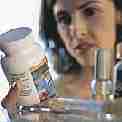Triple Rx Treatment Strategy
A Doctor Recommended Treatment Program For Intestinal Candida Yeast Infections With Three Prescription Drugs
Eradicate Systemic Yeast And Intestinal Yeast At The Same Time
As described in the TREATMENT PLAN, eradicating Candida from the GI tract requires three separate treatment modalities: A. clearing yeast from the mouth and esophagus to prevent reseeding the GI tract, B. removing yeast from the interior of the intestinal tract (the lumen -- where the water goes in the hose), and C. systemic treatment to kill yeast that has permeated the intestinal wall.
A treatment strategy directed at these three modalities is espoused by Dr. Elmer Cranton, MD, who operates two small clinics focused on treatment of conditions such as Candida and Chronic Fatigue. The following description capsulizes the treatment program espoused by Dr. Cranton.
Yeast and fungus develop resistance to antifungal medicines, and a significant percentage of yeast and fungus in the body at any given time will be resistant to any one specific medicine. For these reasons, and to target treatments in the three modalities expressed above, it has been much more effective in clinical practice to combine several antifungal medicines simultaneously. Two and preferably three of the following prescription medicines are given together to achieve remission. The preferred "Triple Therapy", is the simultaneous daily administration of 1. nystatin powder, 2. oral amphotericin-B, and 3. either Sporanox or Diflucan. The triple therapy has led to lasting improvement in a large percentage of patients who had previously been resistant to therapy. Patients should continue all three medicines until clinical tests demonstrate a significant reduction in the presence of Candida. The dietary restrictions should be continued until the yeast overgrowth is cleared.
|
Nystatin powder is used to treat oral and esophageal yeast as well as Candida yeast overgrowth in the intestines. Nystatin is one of the least toxic of prescription drugs. It is safer to use than most nonprescription products.
The preferred form is pure nystatin powder under the brand names Nilstat and Mycostatin - generic forms of nystatin are also available but they tend to be bitter. Nystatin powder is preferred over tablets or capsules because the tablets and capsules do not dissolve until they reach the stomach (or lower) and are therefore are not effective in eradicating the yeast infection from the mouth and throat. Additionally, it would be impractical to achieve the desired dosage levels with commercially available suspensions or nystatin lozenges due to the lower dosages contained in these preparations. The pure powder is much more effective, but it is usually only available from compounding pharmacies -- see our page on SCORING SPECIAL Rx DRUGS for more information.
The recommended dose of nystatin powder is 1/2 teaspoon four times daily (which is equivalent to 4 tablets containing 500,000 units each, totaling 2 million units, four times per day). This is twice the dose customarily prescribed by most physicians. Nystatin is not absorbed from the digestive tract in any significant amount and is an extremely safe medication, even at higher doses. This recommended dosage is what works best in practice. Doses as high as 1 or more teaspoons, 4 times daily, have been used safely.
Dissolve the nystatin powder in the mouth -- place it on the tongue dry by inverting a half-teaspoon in the mouth and tapping the spoon against the upper teeth, then allow the powder to mix with saliva. Rub it into the tongue and swish it around for several minutes in contact with the tissues in the mouth and throat, before swallowing.
If saliva is not adequate, a small sip of water or juice may be used to swish the powder into the mouth, making a paste to coat the gums and tissues. Small children may object to the taste unless a small amount of fruit juice or applesauce is used to mask the taste of medicine. The more concentrated the nystatin, the more effective it will be.
Nothing should be taken by mouth for 20 to 30 minutes after taking the nystatin powder. This allows a coating to remain in the mouth and upper digestive tract long enough to eliminate yeast in those locations. Prolonged administration is usually necessary--several months (occasionally a year or more) before full benefit is achieved.
Patients with symptoms of sore tongue, canker sores, indigestion and heart burn (hiatal hernia or esophagitis) improve more quickly following treatment with nystatin powder--providing evidence that yeast overgrowth is at least partly responsible for those symptoms.
Nystatin powder should be stored in a refrigerator if kept for a prolonged period, although a few weeks at room temperature will not cause a problem. Nystatin slowly takes on a bitter taste at temperatures higher than 80 degrees Fahrenheit. Nystatin should not be exposed to high temperatures or left in a parked automobile on a hot, sunny day. Taste and bitterness normally vary somewhat from batch to batch.
Female patients may improve more rapidly with the simultaneous use of small doses of an anti-yeast vaginal cream, one-half applicator or less once daily at bedtime, when symptoms of vaginitis are present. Some yeast are normally present on vaginal tissues and even small numbers may increase symptoms in a highly sensitized patient. Keeping yeast colonization to a minimum throughout the entire body for several months lowers stress on the immune system and allows gradual recovery
Once the nystatin is swallowed, it will continue its fungicidal activity in the throat, and then throughout the entire GI tract as it passes through the intestinal system..
|
Amphotericin-B is an antifungal drug which, like nystatin, is very safe and not absorbed systemically when taken by mouth. (The injectable and IV forms of amphotericin-B are quite toxic, however, and their use is restricted to treatment of life-threatening systemic fungal infections.) Although both amphotericin-B and nystatin are fungicidal, Amphotericin-B is even more potent than nystatin. It is used in the same fashion and in combination with nystatin to treat yeast infections of the mouth, throat, and the interior of the intestinal tract.
The oral form of amphotericin-B is very safe and nontoxic. Oral forms of pure amphotericin-B are presently available in the United States only from compounding pharmacies -- see our page on SCORING SPECIAL Rx DRUGS for more information. The best form of amphotericin-B is a powder inside 250 mg or 500 mg capsules. The capsules can be opened and emptied into the mouth along with the nystatin -- amphotericin-B does not have a bad taste. In this fashion, both amphotericin-B and nystatin, two of the most potent antifungal medications available, deliver a lethal punch to yeast infections from one end to the other of the entire GI tract.
Amphotericin-B for oral administration can also be obtained at pharmacies in many other countries (often without a prescription). It is sold in France, on prescription only, under the brand name Fungizone, in 250 mg capsules. In Germany the prescription form is called Ampho-Moronal, as 100 mg tablets.
Patients recover more quickly and often remain well without further medication when amphotericin-B is combined with nystatin and Sporanox or Diflucan therapy. The targeted treatment of Sporanox or Diflucan is yeast that has penetrated into the intestinal wall. This yeast growth can only be reached by systemic medications carried by the blood stream to the targeted site.
|
Sporanox (itraconazole) is taken by mouth in capsule or oral suspension form (the oral suspension is more fully absorbed). Because most of it is absorbed, Sporanox is not effective for reducing yeast inside the intestinal cavity. The usual dose is one or two 100-mg capsules taken once or twice daily (100-400 mg/day) with meals. Absorption is better with high gastric pH, such as when food is in the stomach.
Sporanox is indicated in preference to Diflucan (described below) when skin or nails are affected by yeast or fungus. Sporanox is concentrated to a greater extent in skin and nails.
|
Diflucan (fluconazole) is very similar to Sporanox. Diflucan seems to work somewhat better when vaginal yeast is a symptom. Concentrations of Diflucan in body fluids are somewhat higher than Sporanox but Diflucan is not concentrated as much in skin and nails. Otherwise, in practice there does not seem to be much difference between Diflucan and Sporanox. It probably does not make much difference which one of the two medicines is used.
Either Sporanox or Diflucan are used alternatively as one of the three antifungal medicines administered in combination, but Sporanox and Diflucan are never prescribed together.
SUPPLEMENT THE TRIPLE Rx WITH OTHER YEAST KILLERS
Intestinal yeast is notoriously hard to kill. While Dr. Cranton obviously leans toward the exclusive use of prescription medications, many other health professionals believe in the concurrent application of both prescription and nonprescription fungicides because intestinal yeast is so hard to eradicate. Many of the available remedies are of proven effectiveness, especially as stated on our page regarding lab tests. There is common belief that you should take a variety of fungicidal medications in combinations, and on a rotational basis to avoid the possibility that the yeast will become resistant. Please see our Product Guide for our recommendations.
NOTES:
Difficult cases of oral Candidiasis may require systemic drug treatment in addition to the topical AmB and nystatin therapy. Thus, the roll of the system drugs in items 3A and 3B may have the dual purpose of treating both the oral cavity as well as the intestinal wall.
The clotrimazole troche has been proven to be effective in treating oral Candidiasis, however, it is currently only available in low doses (a 10 mg lozenge), and so might have limited benefit when distributed throughout the GI tract.
Other experiences indicate that ketoconazole (Nizoral) may be more effective than either itraconazole or fluconazole for systemic treatment of Candida, although ketoconazole has more side effects.
Dr. Cranton operates the Mount Rogers Clinic in Trout Dale, Virginia, and the Mount Rainier Clinic in Yelm, Washington. Please see his site at http://www.drcranton.com for more information.




